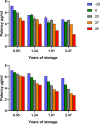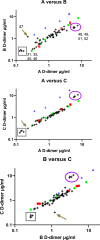Is it possible to make a common reference standard for D-dimer measurements? Communication from the ISTH SSC Subcommittee on Fibrinolysis
- PMID: 34653304
- PMCID: PMC9299488
- DOI: 10.1111/jth.15555
Is it possible to make a common reference standard for D-dimer measurements? Communication from the ISTH SSC Subcommittee on Fibrinolysis
Abstract
Background: D-dimer antigen is a heterogeneous mixture of fibrin degradation products that when present at high levels in plasma indicate ongoing coagulation and fibrinolysis. The heterogeneous nature of the target D-dimer antigen and the variety of assay systems means that it is difficult to compare results from different methods.
Objectives: To identify a universally agreed D-dimer standard that could help harmonize results from different methods.
Methods: A pool of patient plasma with high D-dimer levels was freeze-dried and investigated as a long-term World Health Organization international standard for D-dimer. Fibrin degradation products from clot lysis reactions were also freeze-dried in various formulations and investigated in commutability studies with patient plasma.
Results: Problems of instability of D-dimer plasma emerged suggesting loss of reactivity after freeze-drying and storage at -20°C of 10%-18% per year. Freeze-dried fibrin degradation products added to plasma were also unstable, but the sugar trehalose was found to improve stability. However, this preparation was not suitable as a standard in widely used assay platforms. Previous studies suggest fibrin degradation products are prone to structural rearrangements and amyloid formation, which may explain the instability of candidate D-dimer standards.
Conclusions: The known difficulties of D-dimer standardization are compounded by instability of D-dimer antigen after freeze-drying, described in this report. Fibrin degradation products added to plasma and stabilized by trehalose are not suitable as a standard for D-dimer measurement harmonization. Trehalose stabilization of pooled patient plasma containing high D-dimer levels may produce a useful standard, but this requires confirmation.
Keywords: D-dimer; amyloid; fibrin degradation; protein aggregation; standardization.
© 2021 Crown copyright. Journal of Thrombosis and Haemostasis published by Wiley Periodicals LLC on behalf of International Society on Thrombosis and Haemostasis. This article is published with the permission of the Controller of HMSO and the Queen's Printer for Scotland.
Conflict of interest statement
The authors have no conflicts of interest.
Figures






Similar articles
-
Prothrombotic Fibrin Clot Phenotype Is Associated With Recurrent Pulmonary Embolism After Discontinuation of Anticoagulant Therapy.Arterioscler Thromb Vasc Biol. 2017 Feb;37(2):365-373. doi: 10.1161/ATVBAHA.116.308253. Epub 2016 Dec 29. Arterioscler Thromb Vasc Biol. 2017. PMID: 28062504
-
Measurement of plasma fibrin D-dimer levels with the use of a monoclonal antibody coupled to latex beads.Am J Clin Pathol. 1987 Jan;87(1):94-100. doi: 10.1093/ajcp/87.1.94. Am J Clin Pathol. 1987. PMID: 3541576
-
Validity of enzyme-linked immunosorbent assays of cross-linked fibrin degradation products as a measure of clot lysis.Circulation. 1990 Oct;82(4):1159-68. doi: 10.1161/01.cir.82.4.1159. Circulation. 1990. PMID: 2119264
-
Fibrin D-dimer in thrombogenic disorders.Semin Thromb Hemost. 2000;26(1):101-7. doi: 10.1055/s-2000-9811. Semin Thromb Hemost. 2000. PMID: 10805290 Review.
-
Fibrin degradation products, fibrin monomer and soluble fibrin in disseminated intravascular coagulation.Semin Thromb Hemost. 2001 Dec;27(6):657-66. doi: 10.1055/s-2001-18870. Semin Thromb Hemost. 2001. PMID: 11740689 Review.
Cited by
-
Analytical performance of a new immunoturbidimetric D-dimer assay and comparison with available assays.Res Pract Thromb Haemost. 2022 Feb 6;6(1):e12660. doi: 10.1002/rth2.12660. eCollection 2022 Jan. Res Pract Thromb Haemost. 2022. PMID: 35146238 Free PMC article.
-
Standardization of D-dimer reporting in the COVID-19 era.Res Pract Thromb Haemost. 2022 Sep 20;6(6):e12772. doi: 10.1002/rth2.12772. eCollection 2022 Aug. Res Pract Thromb Haemost. 2022. PMID: 36186103 Free PMC article. No abstract available.
-
Advances in D-dimer testing: progress in harmonization of clinical assays and innovative detection methods.Anal Bioanal Chem. 2024 Jul;416(16):3737-3750. doi: 10.1007/s00216-024-05207-x. Epub 2024 Mar 20. Anal Bioanal Chem. 2024. PMID: 38503987 Review.
-
Unified calibration of D-dimer can improve the uniformity of different detection systems.Pract Lab Med. 2024 Jun 8;40:e00413. doi: 10.1016/j.plabm.2024.e00413. eCollection 2024 May. Pract Lab Med. 2024. PMID: 38974938 Free PMC article.
-
D-dimer diagnostics: can I use any D-dimer assay? Bridging the knowledge-to-action gap.Res Pract Thromb Haemost. 2024 Feb 1;8(1):102335. doi: 10.1016/j.rpth.2024.102335. eCollection 2024 Jan. Res Pract Thromb Haemost. 2024. PMID: 38433976 Free PMC article.
References
-
- Gaffney PJ, Edgell T, Creighton‐Kempsford LJ, Wheeler S, Tarelli E. Fibrin degradation product (FnDP) assays: analysis of standardization issues and target antigens in plasma. Br J Haematol. 1995;90:187‐194. - PubMed
-
- Adam SS, Key NS, Greenberg CS. D‐dimer antigen: current concepts and future prospects. Blood. 2009;113:2878‐2887. - PubMed
-
- Gaffney PJ, Lane DA, Kakkar VV, Brasher M. Characterisation of a soluble D dimer‐E complex in crosslinked fibrin digests. Thromb Res. 1975;7:89‐99. - PubMed
-
- Whitaker AN, Rowe EA, Masci PP, Gaffney PJ. Identification of D dimer‐E complex in disseminated intravascular coagulation. Thromb Res. 1980;18:453‐459. - PubMed
-
- Rylatt DB, Blake AS, Cottis LE, et al. An immunoassay for human D dimer using monoclonal antibodies. Thromb Res. 1983;31:767‐778. - PubMed
MeSH terms
Substances
LinkOut - more resources
Full Text Sources

